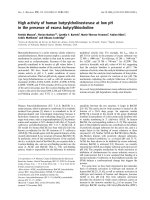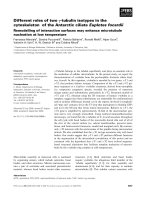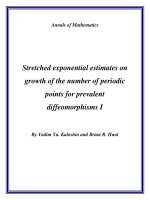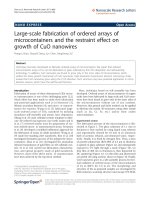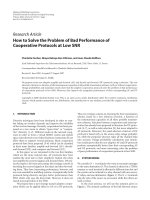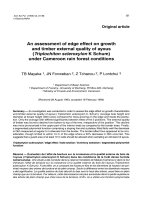Effect on growth of cucumber seedlings at low temperature
Bạn đang xem bản rút gọn của tài liệu. Xem và tải ngay bản đầy đủ của tài liệu tại đây (992.61 KB, 49 trang )
THAI NGUYEN UNIVERSITY
UNIVERSITY OF AGRICULTURE AND FORESTRY
NGUYEN HA TRANG
EFFECT ON GROWTH OF CUCUMBER SEEDLING AT LOW
TEMPERATURE
BACHELOR THESIS
Study mode: Full-time
Major:
Environmental Science and Management
Faculty:
Advanced Education Program Office
Batch:
2014 - 2018
Thai Nguyen, 16/08/2018
Thai Nguyen University Of Agriculture And Forestry
Degree Program:
Bachelor of Environmental Science and Management
Student name:
Nguyen Ha Trang
Student ID:
DTN 1454290033
Thesis Title:
EFFECT ON GROWTH OF CUCUMBER SEEDLINGS AT
LOW TEMPERATURE
Supervisor (s):
Dr. Duong Van Thao, Thai Nguyen University of Agriculture
and Forestry.
Assist. Professor San-Gwang Hwang, National Chung Hsing
University, Taiwan.
Supervisor’s
signature
Abstract:
Low temperature stresses are major environmental limiters for horticultural production
in greenhouses in Taiwan during winter period. The exposure of tropical and
subtropical plants such as cucumber (Cucumis sativus L.) to low temperatures
constitutes a severe limitation to their seedling establishment, physiology and
production. In this study, six cucumber cultivars (CU-87, CU-127, Cuigu, Kappa
i
summer no.7, Kappa summer no.11, CU-74) were cultivated from seed to the
seedlings which have two true leaves for testing in control conditions (25/18˚C,
day/night), chilling treatment (7/4˚C, day/night) and upon re-warming to (25/18˚C,
day/night). In this study, series of experiments about cucumber seedlings treated with
low temperature were tested to see whether their chilling tolerance would be
significantly affected; and compare the effects of a cold treatment on membrane
integrity of six cucumber cultivars and their recovery. The results showed that
cucumbers were sensitive to chilling stresses, which made the leaves wither in some
cucumber seedlings and inhibited cucumber growth in this study. Finally, Kappa
summer no.7 exhibited as the highest cold resistance cultivar which is suitable for
using in winter weather.
Key-words:
Low temperature, cucumber cultivars, cucumber seedling,
Kappa summer no.7, cold resistance.
Number of pages:
39
Date of submission:
16/08/2018
ii
ACKNOWLEDGEMENT
I would like to acknowledge everyone who played a role in my academic
accomplishments. First of all, I would like to emphasize the sincere appreciation
to my university - Thai Nguyen University of Agricultural and Forestry which
gave me a chance to do my thesis abroad. The internship opportunity I had with
Horticulture Department- National Chung Hsing University was a great chance for
learning and experiencing. Therefore, I consider myself as a very lucky individual as I
was provided with an opportunity to be a part of it.
I would like to express my deep and sincere gratitude to Prof. San Gwang
Hwang for the continuous support of my internship study and research. He always
helped me any time and also gave me the best conditions, supported all materials
for my research and discussed any problems I got whenever I did experiment in
his Vegetable laboratory.
Special thanks must go to Dr. Duong Van Thao who always supported and
cheered me up whole the time. He gave me valuable and constructive comments on the
manuscript and helped me to increase the quality of the thesis.
I wish to express my sincere thanks to Wayne Shih- a master student who
helped me a lot for my experiment during the time I worked with him. Without his
assistance and dedicated involvement in every step throughout the process, this paper
would have never been accomplished.
I would like to thank the lab mates for their help and sharing during the time I
worked at the Vegetable laboratory. My thankfulness would also send to my friends
iii
who have been studying in NCHU for their sharing to overcome all obstructs in the
study-time, we have had useful discussions for my research.
Finally I deeply thank my parents, who supported me with love and
understanding. It was their love that raised me up again when I got weary. Without
you, I could never have reached this current level of success.
Sincerely,
Nguyen Ha Trang
iv
TABLE OF CONTENT
LIST OF FIGURES ...................................................................................................... vii
LIST OF TABLES ...................................................................................................... viii
LIST OF ABBREVIATIONS ....................................................................................... ix
PART I. INTRODUCTION ............................................................................................1
1.1 Research rationale .....................................................................................................1
1.2 Research’s objectives ................................................................................................3
1.3 Research questions and hypotheses ...........................................................................3
1.4 Limitations .................................................................................................................3
1.5 Definitions .................................................................................................................4
PART II. LITERATURE REVIEW ................................................................................5
2.1 An overview about six cucumber cultivars ...............................................................6
2.2 Effect of chilling on the physiological processes in chilling-sensitive plants...........7
2.3 Cell membrane changes .............................................................................................9
PART III. METHODS...................................................................................................12
3.1 List of instruments ...................................................................................................12
3.2 List of chemicals......................................................................................................12
3.3 Materials ..................................................................................................................14
3.4 Plant growth and conditions ....................................................................................14
3.5 Experimental design ................................................................................................15
3.5.1 Change of chlorophyll fluorescence .....................................................................15
3.5.2 Cold injury symptom ............................................................................................16
3.5.3 Leaf electrolyte leakage ........................................................................................16
v
3.5.4 MDA content measurement ..................................................................................17
3.6 Statistical analysis ...................................................................................................18
PART IV. RESULTS ....................................................................................................19
4.1 Chlorophyll fluorescence (Fv/Fm) ..........................................................................19
4.2 Severity of chilling injury........................................................................................23
4.3 Leaf electrolyte leakage ...........................................................................................28
4.4 Malondialdehyde .....................................................................................................29
PART V. DISCUSSION AND CONCLUSION ...........................................................31
REFERENCES ..............................................................................................................34
vi
LIST OF FIGURES
Figure 4.1 Chlorophyll fluorescence of 6 cultivars of cucumber under control ...........19
Figure 4.2 Chlorophyll fluorescence of 6 cultivars of cucumber under 6 days
chilling ...........................................................................................................................20
Figure 4.3 Relative reductions of chlorophyll fluorescence (%) under 3 days
chilling ...........................................................................................................................22
Figure 4.4 Relative recovery of chlorophyll fluorescence (%) after 3 days chilling. ...23
Figure 4.5 Five levels severity of cold injury of the leaves ..........................................25
Figure 4.6 Control group at (a) day 0, (b) recovery day 3. ...........................................26
Figure 4.7 The chilling group at (a) day 0, (b) recovery day 3 .....................................27
Figure 4.8 The severity of chilling injury between first leaf and second leaf of six
cultivars of chilling group .............................................................................................27
Figure 4.9 Leaf electrolyte leakage (%) of 6 cucumber cultivars under chilling ..........29
Figure 4.10 Malondialdehyde (nmol g/FW) of 6 cucumber cultivars under chilling ...30
vii
LIST OF TABLES
Table 2.1. List of vegetables, sensitive to chilling temperatures, the lowest safe
storage temperature and the symptoms of chilling injury ..............................................5
Table 2.2. Six cucumber cultivars information ...............................................................7
Table 3.1. Name and commercial company of all instruments used in this study ........12
Table 3.2. Properties of liquid nitrogen .........................................................................12
Table 3.3. Properties of trichloroacetic acid ..................................................................13
Table 3.4. Properties of thiobarbituric acid ...................................................................13
Table 3.5. Six cucumber cultivars .................................................................................14
Table 3.6. Appearance severity level of cold damage. ..................................................16
Table 4.1 Data of reduction and recovery of chlorophyll fluorescence (%)
of chilling group ...........................................................................................................21
viii
LIST OF ABBREVIATIONS
CI
Chilling injury
EC
Electrical Conductivity
Fv/Fm
Chlorophyll fluorescence maximal quantum efficiency of PSII
MDA
Malondialdehyde
PSI
Photosystem I
PSII
Photosystem II
ROS
Reactive oxygen species
SCI
Severity of cold injury
ix
PART I. INTRODUCTION
1.1 Research rationale
In recent years, climate change has shown global impacts on the human
environment, nature, wildlife. The most vulnerable to climate change is agricultural
plants that are one of society's key sensitivities to climate. Many agricultural plants,
main economic source of some countries and large sectors of world trade, are
extremely susceptible to weather changes. Small or huge amount of rainfall, a hot spell
or cold snap at the wrong time, or extremes, like flooding and storms, may cause a
significant effect on local crop yields. Unexpected climate changes can affect
production of these plants in the most disastrous way. Temperature is continually
changed due to climate change and has become a serious threat to crop yield. As
sessile organisms, plants are constantly exposed to change in temperature and other
abiotic factors. Low temperatures stress or chilling temperature (1–10°C) is one of the
majors abiotic stresses that disturbs cellular physiology, causing oxidation stress via
creating imbalance between generation and metabolism of reactive oxygen species
leading finally to cell and plant death (Lukatkin and Anjum 2014).
The exposure of tropical and subtropical plants such as cucumber (Cucumis
sativus L.) - a frost-sensitive plant species grows best at temperatures above 20°C and
constitutes a severe limitation to their seedling establishment, physiology and
production at low temperatures. The magnitude of chilling injury depends on air
temperature, time of exposition, plant growth stage and it usually manifests itself after
plants are transferred to control temperature. Chilling temperatures in leaves of
sensitive plants cause the degradation of membrane lipids and decrease the integrity of
1
cell membranes which change the composition of photosynthetic pigments, decrease
leaf stomatal conductance and photosynthesis. The reduction in CO2 fixation rate
induced by low-temperature stress leads to excessive accumulation of reactive oxygen
forms and increased activity of antioxidant enzymes.
Low-temperature stresses are major environmental limiters for horticultural
production in greenhouses in Taiwan during the winter period. A characteristic effect
of chilling temperatures on chilling-sensitive plants is growth slowing, more
pronounced in susceptible species and varieties in comparison with the tolerant species
(Ting et al. 1991). In addition, there is a delayed development and lengthening of the
growing season (Skrudlik and Koscielniak, 1996). At the same time, the cucumber
growth is delayed, reducing the number of newly formed plant organs and the rate of
their occurrence, the structure of roots is changed, and flowering rate, fruit rate and
seed filling are reduced (Buis et al. 1988). This thesis sheds light on the determinant
processes involved in the depletion of cucumber seedlings by chilling injuries,
revealing that low temperatures have persistent and detrimental effects on cucumber
cultivars. Moreover, this study showed that exposure of chilling sensitive plants to low
temperature causes disturbances in all physiological processes-water regimes, mineral
nutrition, photosynthesis, respiration and metabolism.
2
1.2 Research’s objectives
The main purpose of this study is to identify the effect of low temperature on
growth of cucumber seedlings. Moreover, this study may help farmers to choose which
cucumber cultivars are suitable for using in the winter cultivation.
1.3 Research questions and hypotheses
•
This study aims to solve the following questions:
1. What are the methods to identify the impact of low temperature on cucumber
seedlings?
2. How do cucumber seedlings change after chilling treatment?
3. Which cucumber cultivars is the coldest resistance?
• Alternative hypothesis:
1. The cucumber seedlings are affected by chilling treatment.
2. There are differences between six cucumber cultivars on the cold resistance.
• Null hypothesis:
1. The cucumber seedlings are not affected by chilling treatment.
2. There are no differences between six cucumber cultivars on the cold
resistance.
1.4 Limitations
There are some limitations appeared in this study such as the internship period
was pretty short and all experiments were based on the plant’s growing, therefore it
totally took a long time to complete each individual experiment. In addition, the results
were not 100% exactly because different cucumber cultivars have different growth rate
and environmental adaptation.
3
1.5 Definitions
Chilling temperatures effects on plants in temperate climates leading to a
reduction or complete crop failure due to either direct damage or delayed maturation.
Most of cucumber cultivars are damaged during chilling temperature. This damage is
called chilling injury which damages chilling-sensitive plant species. Chillingsensitive plants are the plants that are sensitive to chilling and easily to be damaged at
chilling temperatures. The ability of plants in a vegetative state to survive the action of
chilling temperatures without harm to the future growth and development are called
cold resistance (Lukatkin et al. 2012).
4
PART II. LITERATURE REVIEW
Cucumber (Cucumis sativus L.), is a member of the Cucurbitaceae, which
comprises 90 genera and 750 species. It is one of the oldest cultivated vegetable crops
and is cultivated in nearly all countries of temperature zones (Tatlioglu, 1993). It is a
frost-sensitive plant species, growing best at temperatures above 20°C (Table 2.1).
Hundreds of cultivars of varying size and color are now grown in warm areas
worldwide, commercially and in home gardens. A characteristic effect of chilling
temperatures on chilling-sensitive plants is growth slowing, more pronounced in
susceptible species and varieties of comparison with the tolerant species.
Table 2.1. List of vegetables, sensitive to chilling temperatures, the lowest safe
storage temperature and the symptoms of chilling injury (Lukatkin et al. 2012)
Crop
Lowest safe temperature
Chilling injury symptoms
(°C)
Asparagus
0-2
Dull, gray-green, limp tips
Bean (snap)
7
Pitting and russeting
Pitting, water- soaked
Cucumber
7
lesions, decay
Surface scald, alternaria rot,
Eggplant
7
seed blackening
Discoloration, water-soaked
Okra
7
areas, pitting, decay
Pepper
7
Pitting, alter aria rot, seed
5
Crop
Lowest safe temperature
Chilling injury symptoms
(°C)
blackening
Mahogany browning,
Potato
2
sweetening
Decay, especially alternaria
Pumpkin
10
rot
Decay, especially alternaria
Squash
10
rot
Decay, pitting, internal
Sweet potato
10
discoloration
Water-soaking, softening,
Tomato (ripe)
7-10
decay
Tomato (mature-
Poor color when ripe,
13
green)
alternaria rot
2.1 An overview about six cucumber cultivars
The following Table 2.2 is 6 cucumber cultivars information (Cucumis sativus
L.). In this project, the cucumbers were cultivated from seed to the seedlings which
have two true leaves as for test.
6
Table 2.2. Six cucumber cultivars information
Cultivar
CU-87
Rate of female
Country of
Fruit length
flower (%)
origin
(cm)
70-90
Japan
22-14
Characteristics
High yield
High yield, low
CU-127
50
Japan
21
temperature
resistance
Cuigu
Kappa summer
no.7
More female,
Multi female
Taiwan
24
30-50
Japan
21-22
heat-resistant
Japan
20-22
good fruiting rate
Kappa summer
Nearly all
no.11
females
strong branching
Approximately
CU-74
80-90
Japan
21-24
100% female rate
and good fruit rate
in the first stalk
2.2 Effect of chilling on the physiological processes in chilling-sensitive plants
Incubation of chilling-sensitive plants at low temperatures induces disturbances
in physiological processes: water regime, mineral nutrition, photosynthesis, respiration
and total metabolism (Lukatkin et al. 2012). However, photosynthesis is focus to
deeply understand the goal of this research.
Among many physiological processes, photosynthesis is one of the most
sensitive to cold stress, which is the main reason for the reduction or cessation of
growth and decreases in productivity of plants at low temperatures. Photosynthesis
includes numerous components such as CO2 reduction, photosynthetic photosystems
7
and the electron transport system. Among these, photosystem II has been described as
the most cold-sensitive. This finding has been supported by chilling stress significantly
decreased the maximum PSII quantum yield (Fv/Fm), the Fv/Fm decrease reflects the
damage to photochemical reactions, accompanied by the interdict of electron transport
(inhibition of electron transfer).
Photosystems are functional and structural units of protein complexes involved
in photosynthesis that together carry out the primary photochemistry of
photosynthesis: the absorption of light and the transfer of energy and electrons.
Photosystems are found in the thylakoid membranes of plants which were located in
the chloroplasts of plants and in the cytoplasmic membrane of photosynthetic bacteria.
PSII: is the first protein complex in the light-dependent reactions of oxygenic
photosynthesis that is located in the thylakoid membrane of plants. Within the
photosystem, enzymes take photons of light to energize electrons that are then
transferred through a variety of coenzymes and cofactors to diminish plastoquinone to
plastoquinol. The energized electrons are changed by oxidizing water to form
hydrogen ions and molecular oxygen. By replenishing lost electrons with electrons
from the splitting of water, photosystem II offers the electrons for all of the
photosynthesis to occur.
During and after chilling, the rate of photosynthesis in the leaves of chillingsensitive plants decreased and this is more related to decreasing temperature and
lengthening of chilling period and persisted for a long time after transfer of chilled
plants in the heat (Kingston et al. 1999). The physiological reasons for the suppression
of photosynthesis are the inhibition of phloem transport of carbohydrates from the
leaves, stomata limitation, destruction of the photosynthetic apparatus, damage to
8
water-splitting complex of photosystem II and superoxide (O2.-) rather than O2 is
considered as one kind of ROS, inhibiting electron transport, and uncoupling of
electron transfer and energy storage, alters in the activity and inhibition of synthesis of
major enzymes of the Calvin cycle and C4 cycle. Cold-sensitive plant species have
smaller temperature equilibrium of leaf photosynthesis than cold-tolerant plant species
(Yamori et al. 2009). Chilling of sensitive plants in light had much stronger effects on
the photosynthetic apparatus than chilling in the dark (Szalai et al. 2006). Photo
inhibition of photosynthesis is the lowering of photosynthetic activity under excessive
illumination during chilling (Nie et al. 2008). It increases with decreasing temperature
and increasing light intensity (Greer, 1995). Primary site photo inhibition is the
photosystem II. However, it was discovered that photo inhibition occurs at relatively
low light and low temperature, and the main site of damage is photosystem I (Sonoike,
1999). Decrease of photosynthesis at chilling temperatures may be a consequence of
photo-oxidative damage to the photosystems in the membranes of chloroplasts, which
is manifested by increasing lipid peroxidation, degradation of chlorophyll, carotene,
and xanthophyll’s (Fryer et al. 1998). It was caused by activated oxygen species and
was associated with reduced antioxidant activity of tissues (Leipner et al. 1997),
(Leipner et al. 2008).
2.3 Cell membrane changes
Low temperatures change the physical properties of cell membranes in plants.
Chilling of sensitive plants leads to various changes in their membranes, especially is
reduce the membrane elasticity, decreasing theirs preventing lipid inclusion in their
composition, lower lipid fluidity, thereby reducing the activity of several membranebound enzymes, including H+-ATPase, increase the lateral diffusion of phospholipids,
9
sterols and proteins in the plasma membrane (Quinn, 1988), (Kasamo et al. 1992),
(Koster et al. 1994), (Kasamo et al. 2000). Chilling injury is a direct effect of low
temperature on cellular constituents, which results some changes in membrane features
and/or conformational changes in enzymes and structural proteins (Parkin et al. 1989).
Such direct effects are readily reversible if the plant material is transferred to nonchilling temperatures after a short exposure to chilling and before visible injury is
apparent. Therefore, it has been suggested that membrane deterioration is a primary
factor in both the physiological and visible manifestations of chilling injury. After a
long chilling period, these changes lead to loss of membrane integrity and
compartmentation, the electrolyte leakage, decrease of oxidative activity of
mitochondria, increase of the activation energy of membrane-bound enzymes,
reduce the rate of photosynthesis, cause disruption and imbalance of metabolism,
the accumulation of toxic substances and the symptoms of chilling injury (Lyons, 1973).
Membranes are dynamic structures that support numerous biochemical and
biophysical reactions. They are also major targets of environmental stresses (Leshem,
1992). Chilling impairments mainly consist of alteration of metabolic processes
decrease in enzymatic activities, reduction of photosynthetic capacity and changes in
membrane fluidity among others (Dubey, 1997). Such changes are regularly associated
with an increase in membrane permeability, affecting membrane integrity and cell
compartmentation under chilling conditions. Increased rates of solute and electrolyte
leakage occur in a variety of chilled tissues and have been used to evaluate membrane
damage following chilling (Wright and Simon, 1973). Leakage points may result from
the appearance of membrane domains presenting different configurations due to cold-
10
induced changes in lipid phases (Leshem, 1992), or from damage of membrane,
particularly as regards lipids (Harwood, 2005).
Malondialdehyde is one of the final products of stress-induced lipid
peroxidation of polyunsaturated fatty acids (Leshem, 1987) and often used as an index
of cell oxidative damage under environmental stress (Shen, 1997). Low temperature
disrupts the balance of active oxygen species metabolism, leading to their
accumulation and destruction of scavenging enzymes such as SOD, CAT, POD and
APX (Kang and Saltveit, 2002). A general characteristic of various stress factors is
their capability to increase the generation of reactive oxygen species (ROS) in the
cells. In plants, the photosynthetic electron transport is also the main origin of ROS.
Indeed, the production of ROS is unavoidable when the photosynthetic electron
transport chain operates under aerobic conditions. The generation of ROS in
photosynthesizing tissues is significantly exacerbated under environmental stress
conditions. Under these circumstances, the photosynthetic dark reactions are directly
or indirectly down regulated, which results in over reduction of the photosynthetic
electron transport chain, photo reduction of di-oxygen and generation of ROS
including O2.- and H2O2.- and OH.- (Hajiboland, 2014).
Accumulation of ROS such as O2.- and H2O2.- occurred under chilling and was
associated with signs of chloroplast damage. Although low accumulation of ROS is
indispensable, excessive accumulations had been shown to be associated with damage
from lipid peroxidation, and oxidation of protein and DNA. Lipid peroxidation from
excessive ROS leads to structural abnormalities and cell dysfunction (Gill and Tuteja,
2010).
11
PART III. METHODS
3.1 List of instruments
All equipment and machines used in this study are listed in Table 3.1 below.
Table 3.1. Name and commercial company of all instruments used in this study
Name
Model LBG-1000
Commercial Company
Lead-Biotech Instruments Co., Ltd.,
Taichung, Taiwan
Chlorophyll Fluorometer, Mini-Pam, Walz,
Germany
Effeltrich
Mettler Toledo™, EL20 Benchtop pH Meter
Switzerland
Thermolyne/Maxi Mix II
USA
Orbital shaker os701
Kansin instruments Co., Taiwan
High-Speed Refrigerated Centrifuge, CR
21GIII
Hitachi instruments, Japan
Elisa Plate Reader
Japan
3.2 List of chemicals
All chemicals used in this study are shown below.
Table 3.2. Properties of liquid nitrogen
Name
Nitrogen
Chemical formula
N
Appearance
Colorless gas or liquid
Density
0.807 g/mL
Melting point
-210oC (-346oF)
Boiling point
-195.79oC (-320oF)
12
Table 3.3. Properties of trichloroacetic acid (TCA)
Name
Trichloroacetic acid
Chemical formula
C2HCl3O2
Molar mass
163.38 g mol-1
Appearance
Colorless to white, crystalline solid
Density
1.63 g/cm3
Melting point
57-58oC
Boiling point
196-197oC
Molecular formula
Table 3.4. Properties of thiobarbituric acid
Name
Thiobarbituric acid
Chemical formula
C4 H 4 N 2 O 2 S
Molar mass
144.15 g/mol
Melting point
245oC
Molecular formula
13
3.3 Materials
All cucumber cultivars used in this study are listed in Table 3.5 below.
Table 3.5. Six cucumber cultivars
Cultivars
CU87
CU127
Cuigu
Kappa Summer no.7
Kappa Summer no.11
CU74
3.4 Plant growth and conditions
One cucumber seedlings were sowed in each hole and 108 holes fully filled per
tray as one replication that used Potgrond H 90 commercial nursery medium (peat:
perlite = 9:1) from Klasmann-Deilmann, Germany. Cucumber cultivars were placed in
a plant growth chamber to simulate the average winter temperature in central Taiwan
of [25 ± 1/18 ± 1 °C (day/night)] and photoperiod. At 12 hours, the light intensity was
70 μmol m-2 s-1 cultured until the plants had two fully expanded leaves for
experimental use.
After that 18 cucumber seedlings of each cultivar which were strong plants
were chosen for testing. They were divided into 2 groups that are chilling group and
control group. The chilling groups were placed in a low-temperature refrigerator
equipped with a light source at a temperature of [7 ± 0.5 /4 ± 0.5 °C (day/night)] in 3
days, a photoperiod of 12 hours, and a light intensity of 70 μmol m-2 s-1, continuous
low temperature treatment for 3 days.
14
The control group and the recovery conditions after the chilling injury were the
same as the conditions with [25/18°C (day/night)] for cultivating the plant material,
then put plants back at room temperature after low temperature treatment to restore the
plants for 3 days.
3.5 Experimental design
3.5.1 Change of chlorophyll fluorescence (Fv/Fm)
Chlorophyll fluorescence parameter in leaves was measured at room
temperature and dark condition using a photosynthesis yield analyzer (MINI- PAM,
Walz, Effeltrich, Germany). Chlorophyll fluorescence analyzer was used to measure
the part of the second leaf of cucumber plants that avoided the veins. The measured
plants were dark processing for 30 min before they were measured. After calculated by
using formulas, the relative reduction of chlorophyll fluorescence or the relative
recovery of chlorophyll fluorescence of the plant was presented as a percentage (%).
Chlorophyll fluorescence was calculated by a formula:
The relative reduction of chlorophyll fluorescence (%) =
(initial Fv/Fm – after chilling Fv/Fm) / initial Fv/Fm × 100%
The relative recovery of chlorophyll fluorescence (%) =
(after recovery Fv/Fm – after chilling Fv/Fm) / initial Fv/Fm × 100%
The Chlorophyll fluorescence technique offers considerable potential for the
quantitative assessment of CI, as it is rapid, sensitive, non-destructive to the tissue, and
able to detect injury before visible symptoms occur. The fluorometer can provide data
that represent an estimate of quantum yield (Fv/Fm) and the rate of rising in
Chlorophyll fluorescence. The reduction in one of these two parameters has been
15
